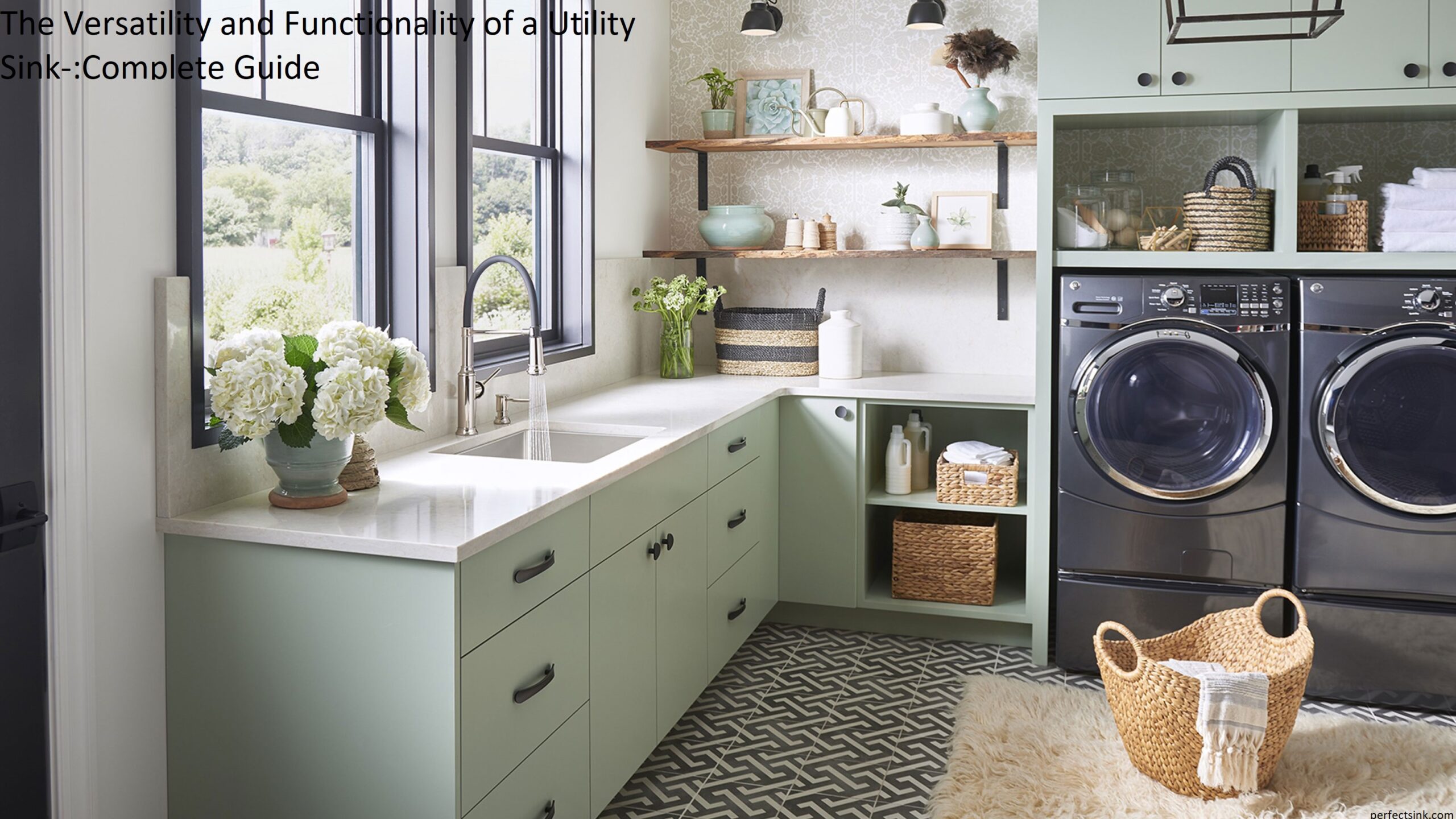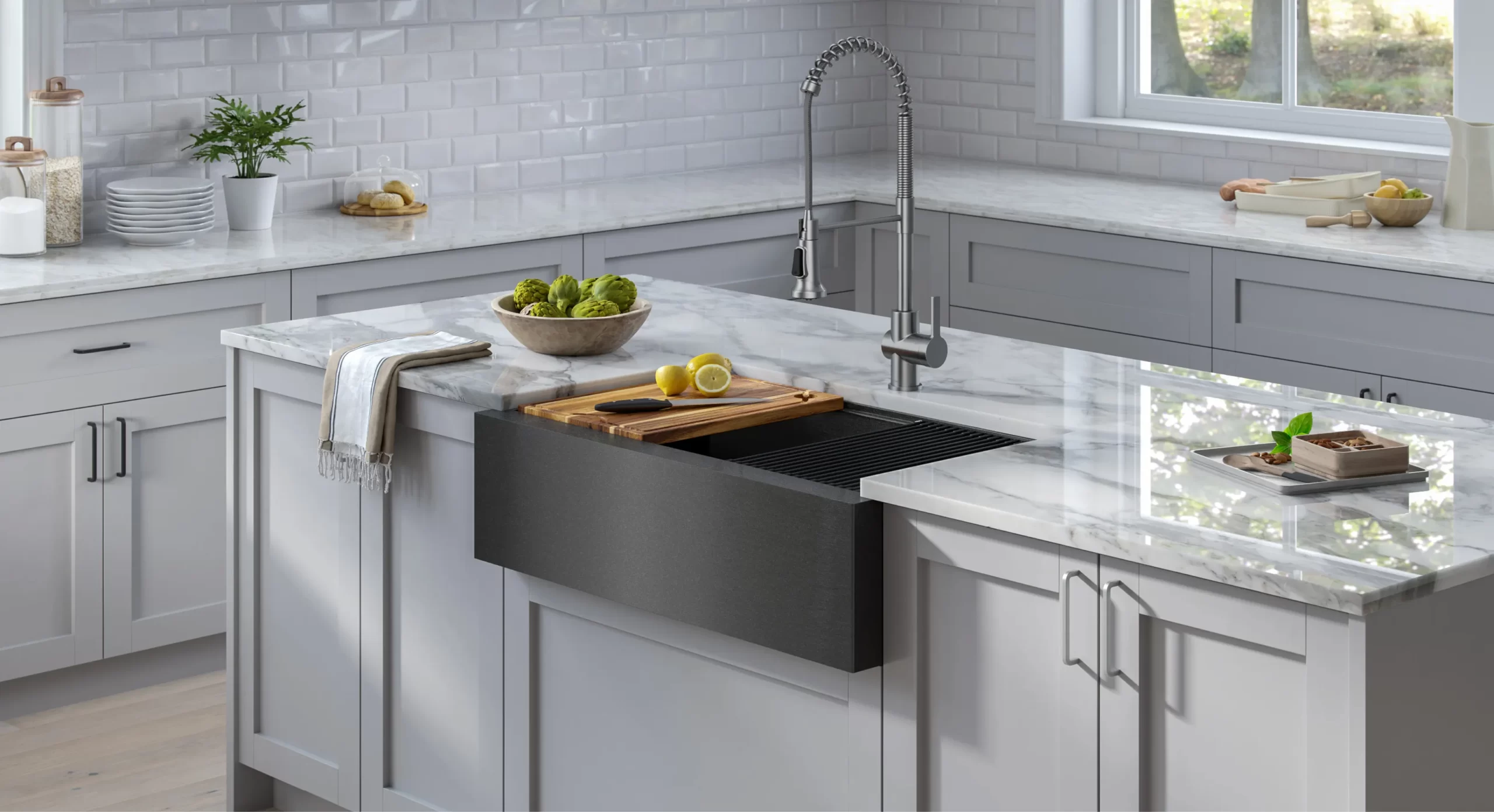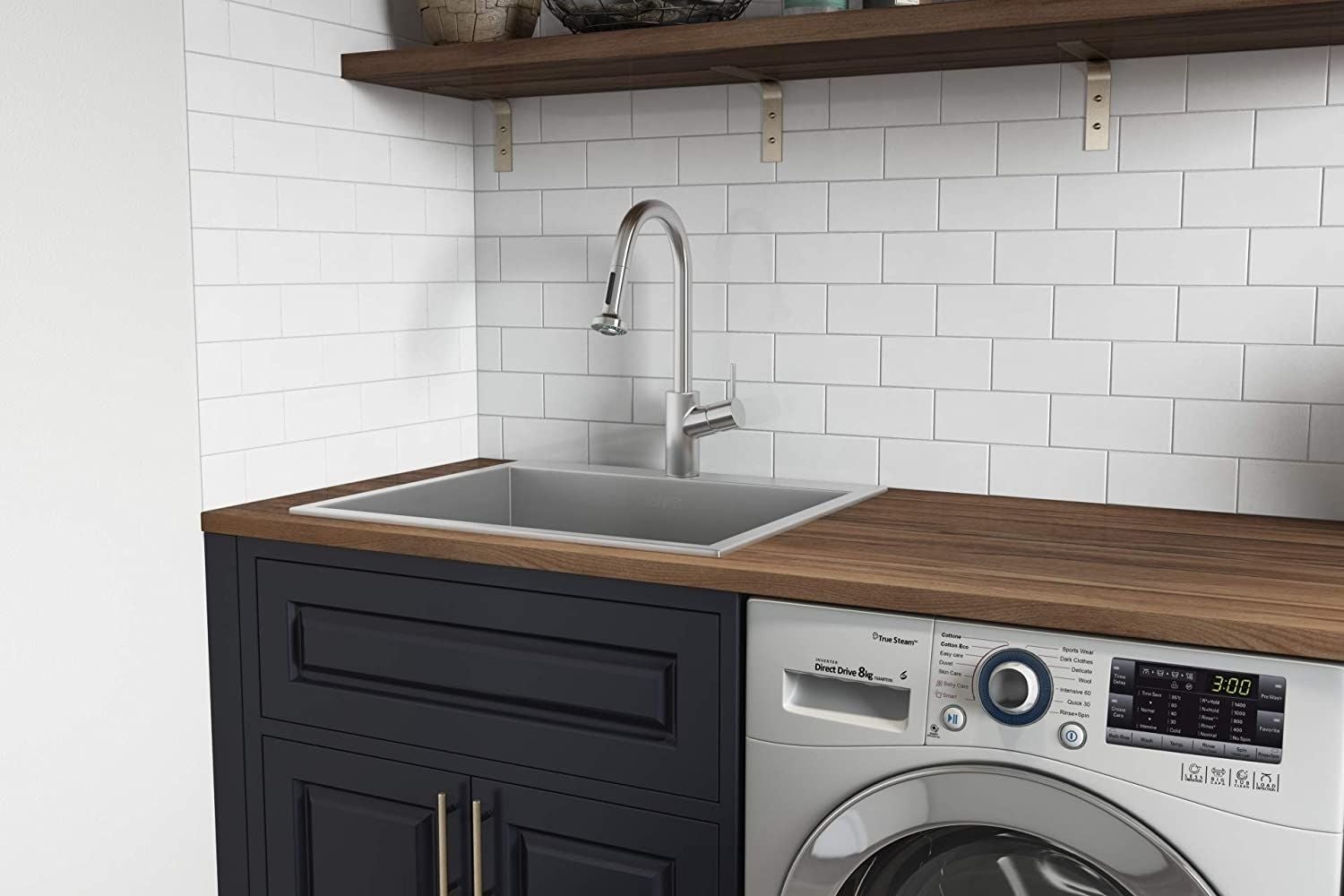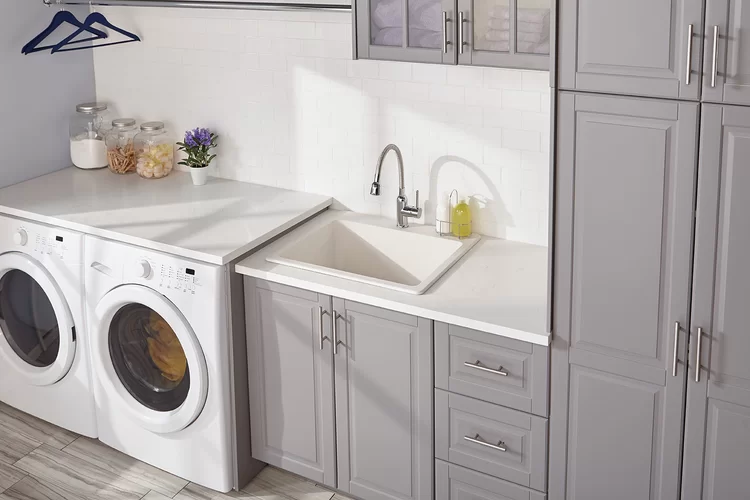Are you feeling overwhelmed by all the options when it comes to choosing a utility sink? Look no further. This guide provides all the information you need to know about utility sinks including its versatile uses, various styles, and overall functionality.
Discover how to add convenient functionality and style to your home with a utility sink.
The utility sink is a practical and versatile addition to any home, providing a space for cleansing or soaking laundry and other items, as well as washing up after tasks such as painting and gardening. These special sinks are available in a wide range of styles and sizes, often with a deep basin, to allow for the easy cleaning of even the largest items. The features offered with this type of product makes it perfect for completing various chores both inside and outside the home.
This guide will offer information on all aspects of the utility sink, from its basic principles to which model is best suited to your needs. This include an overview of its design purposes, places it can be installed inside the home and out in the yard, an understanding of which accessories can enhance its use, as well as a list of tops tips on purchase considerations so you can make the right decision when buying one.

Explanation of what a utility sink is
A utility sink is a type of sink used for a wide variety of tasks, such as washing large items, cleaning up messes, and filling buckets or containers with water.
Utility sinks can be made of various materials, including plastic, stainless steel, porcelain and cast iron. Generally they have deep basins and sturdy construction so they can handle heavy duty use.
They are also often used in garages or basements where there may not be much space for a regular size sink to fit. This makes them the perfect choice for cleaning up after carpentry, DIY projects or exterior power washing.
Some utility sinks even come with added features such as shelves for easy storage access and a slop sink that catches any overflowing water to keep your floors dry.
Utility sinks are an incredibly versatile and functional addition to any workspace or garage!
Importance of utility sinks
A utility sink plays an important role in any home. It allows users to not only take care of messy tasks, but also clean bigger items such as tools and even larger pieces of clothing. It is also ideal for storing and organizing detergents, cleaning products, and other household items. Many people also find that a utility sink can be useful for bathing pets or washing out dirty dishes while they are outside and on the go.
The design of a utility sink is generally totally different from that of a regular kitchen or bathroom sink, allowing it to have more functionality than just being used as another place to wash dishes or run water. Utility sinks are often made from stainless steel due to its robustness, being able to resist corrosion and maintain its quality over time. Other materials used might include cast iron, enamel or fire clay depending on the desired look and purpose of the user’s appropriation.
Adding additional features such as goosenecks, ribbing inside the bowls or integral drain boards can be extremely helpful for various tasks that require specific conditions not provided by regular sinks, such as drainage channels that are removable in order to make them easier to clean after use. These features increase the overall effectiveness of a utility sink by doubling their capacity for different cleaning tasks such as soaking clothes prior to laundering them.
Features to Consider When Choosing a Utility Sink
Choosing the right utility sink for your needs is important, as there are many features to consider. Before you buy, familiarize yourself with these common features to find a sink that looks good and functions properly in your space:
Size: The size of the utility sink is important as it will determine how much it can hold. Consider the amount of space you have and choose a sink that fits in the space comfortably but will still provide enough volume for washing whatever items you’ll be dealing with.
Depth: This may be a more relevant consideration when choosing a backyard utility sink, as the purpose of this type of fixture is often to contain water running off surfaces nearby. For indoor models, choose a depth that works best for activities such as filling buckets or giving large pots and pans ample room to sit in the basin.
Installation Type: Most utility sinks come with connections that allow them to be installed either on-counter or drop-in style — both are suitable for most applications. However, keep in mind that there are some models available that require wall-mounting or direct connection to drainage pipes. Determine what type of installation will work best based on your existing setup and preferences before moving forward with one style over another.
Color and Material: Utility sinks typically come in different color options and made from various materials such as stainless steel, porcelain, composite granite, cast iron and acrylic/fiberglass blend. Select a material based on how durable it is likely to be against chipping and staining over time — stainless steel is one option typically chosen for its longevity — then select an aesthetic finish (generally white or black) that matches your current bathroom decor scheme.
Size and Capacity

When selecting a utility sink, it’s essential to begin by measuring the space in which it will be installed. All utility sinks come in a variety of sizes and capacities, so you must know how much water the task requires before choosing a sink. Oftentimes, a large capacity basin is preferred for chores such as washing cars or larger items. Utimately, the size of the sink you choose should reflect your needs and lifestyle based on the type of tasks being performed with it.
In addition to taking into account size requirements, it’s important to consider water pressure and flow rate when selecting a utility sink. Many units come equipped with an aerator spray head to regulate water flow. This type of feature helps ensure that water won’t splash out of the basin while increasing energy efficiency. Additionally, inset models have sufficient room for a small drainage hole in the bottom of the unit that allows for easy cleaning without requiring access from behind or below it. It’s beneficial to research how much drain capacity is available before purchase so you can better plan your task workflow around this feature from day one.
Depth
One of the key factors in choosing a utility sink is the depth. The minimum standard is 12” deep, but many users opt for models that are even deeper at 15” or 18”. The extra depth allows you to submerge containers, such as buckets or hoses, and provides greater stability when scrubbing larger items that don’t fit in conventional kitchen sinks.
Deeper depths also accommodate taller users better and can help to reduce back strain when reaching deep into the basin. Finally, deeper utility sinks provide more space for all your cleaning needs so that you don’t have to empty and fill it as often.
Faucet Configuration
When considering your faucet configuration for your utility sink, you want to make sure you choose one that will suit the needs of your space and accommodate any future changes that you might make. Faucets come in a variety of designs, with the most common being wall-mounted or deck-mounted. Wall-mounted faucets are attached directly onto the wall behind the sink and are usually installed over a hole in the wall from which it can draw water. The other kind is deck-mounted, which is mounted on a separate base that is connected to the floor. In this case, there must be enough space behind the sink for installation.
If space permits in your utility room, a swivel faucet can be quite useful as it gives more flexibility and visibility to work under higher fixtures. A second type of faucet is known as a pot filler faucet and adds convenience if you have large items such as large pots or serving trays to fill with water without having to move them to another location near the tap or transfer it manually into the sink. When purchasing these types of sinks, consider what type of fixtures or additions you may require down the line when choosing an appropriate model for installation.
Materials Used to Make Utility Sinks

When selecting a utility sink, it is important to consider the type of material used to construct the sink. Having a good understanding of the different materials available can help you make an informed decision on which type is best suited for your particular project.
Common materials used to make utility sinks include:
-Stainless steel: Stainless steel has long been the go-to choice for many kitchen and bathroom sinks, and is great for use in a utility sink as it is easy to clean and bacteria resistant. Stainless steel does not conduct heat very well and so this material is not ideal if you plan on frequently washing items that are prone to get very hot such as cookware or clothing fresh from an iron.
-Acrylic: Acrylic may be a better option if you are looking for a lighter weight unit than stainless steel. Acrylic can be easily cleaned with soap and water but typically needs more frequent maintenance in order to maintain its good looks – acrylic also dulls over time from exposure to cleaning chemicals or other harsh materials.
-Cast iron:Cast iron makes an incredibly strong sink but can be difficult to clean due its weight and surface porosity which can cause staining or buildup of dirt over time. Cast iron also rusts relatively quickly if it’s not properly cared for so this material may not be best suited in areas with high humidity such as laundry rooms, basements or bathrooms with inadequate ventilation.
Stainless Steel
A stainless steel utility sink can be a great addition to any workspace, from a home workshop to a professional kitchen or laundry room.
Stainless steel sinks are known for their durability and ease of maintenance. Many models are made from thicker gauge stainless steel, making them highly resistant to scratches and rust. They also tend to hold up well in the event of an accidental drop or pressure on the sides of the sink.
Stainless steel utility sinks are also easy to clean because they do not absorb liquid or odors, making them much less prone to bacteria buildup than other materials such as enameled ceramic or porcelain. Additionally, many models offer features such as an elevated basin or adjustable feet for greater convenience in installation and use.
Porcelain
Porcelain sinks offer a combination of functionality and style. They can be used in any space, from a modern gourmet kitchen to a cozy country kitchen. Porcelain is a classic material that has been around for centuries, but it has seen many advances over the years. It has become more durable and resistant to chipping, stains, and scratches.
The classic white porcelain sink can be updated with different color finishes, such as black or grey, or an antique finish for added personality. Porcelain sinks are also more affordable than other materials and come in a variety of shapes and sizes to meet your needs.
Fiberglass

Fiberglass is a common material used in various types of utility sinks. Fiberglass is an inexpensive and easy-to-clean option that provides exceptional strength and durability. Many fiberglass utility sinks are molded or formed into realistic shapes and can feature beautiful design elements that add to the overall look of your laundry or mudroom.
Because fiberglass utility sinks are available in a range of colors, they can usually be matched to the existing decor of your space with ease. Some fiberglass utility sinks may require special cleaning products which should be tested on a small area before using them more broadly over the entire surface of the sink.
One benefit of this material is that it is safe for use with hot water applications like bleaching and washing whites, so you can rest assured knowing that you have selected a material that can withstand those higher temperatures without any damage.
Conclusion
In conclusion, a utility sink is an important addition to any laundry room or outdoor area. Consider the features and materials carefully before making a purchase and make sure you find one that meets your needs. Remember to check the installation instructions before completing the job. Finally, add the detailed finishing touches to give your utility sink the perfect look for your space. With this guide, you can enhance your home with a functional and stylish plumbing solution that provides versatility and style in one convenient package.
FAQ’s
What is the purpose of a utility sink?
A utility sink is typically used for heavy-duty cleaning tasks such as washing large items, soaking laundry, or cleaning tools.
What is a utility sink called?
A utility sink is also known as a laundry sink, slop sink, or mop sink.
What is the difference between a laundry sink and a utility sink?
A laundry sink is typically used for washing laundry, while a utility sink is used for a variety of heavy-duty cleaning tasks.
What is a utility sink in a restaurant?
A utility sink in a restaurant is used for washing large pots and pans, cleaning food prep equipment, and other heavy-duty cleaning tasks.
What are the benefits of a laundry sink?
A laundry sink provides a convenient place to wash and soak laundry, which can help to prevent staining and damage to clothing.
What is utility sink made of?
Utility sinks are typically made of durable materials such as stainless steel, porcelain, or composite materials.
What is the importance of a sink in a kitchen area?
A sink in a kitchen area is important for food preparation, dishwashing, and general cleaning tasks.
Why are utility sinks so deep?
Utility sinks are often deeper than standard sinks to accommodate larger items and to provide more space for soaking and cleaning.
Can utility sink be used as kitchen?
While utility sinks can be used in a kitchen area, they are typically designed for heavy-duty cleaning tasks and may not be as well-suited for food preparation and dishwashing.
How wide is a utility sink?
The width of a utility sink can vary, but they are typically larger than standard kitchen sinks to accommodate larger items.
See Also:
- Best toy sink with running water 2023
- Best collapsible sink for camping 2023
- Best stainless steel farmhouse sink 2023
- Best sink strainer 2023
- Best caulk for kitchen sink 2023

